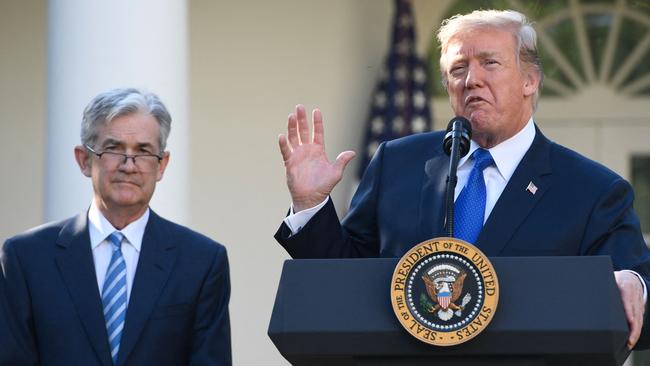Rebounding Aussie stocks face a reality check in the face of expected earnings downgrades
Analysts say the strong performance of the sharemarket faces a reality check, and the lofty valuations of the big banks in particular will be scrutinised as earnings reports come in.

Business
Don't miss out on the headlines from Business. Followed categories will be added to My News.
It’s been an impressive rebound but the recovery of Australia’s ASX 200 stock index over the past three weeks to price levels exceeding what prevailed immediately before the April 2 tariff announcements now looks vulnerable to earnings downgrades.
That’s the view of UBS Australia equity strategist Richard Schellbach. Mr Schellbach this week shifted his sector strategy to lower the overall risk of his model portfolio after slashing his year-end target for the ASX 200 to 8150 points from 8850 last week.
While offshore investors have viewed Australia’s major bank shares as a refuge from the trade war, given their relatively limited impact from US tariffs, Macquarie Equities and Morgan Stanley similarly warn of a reality check from earnings reports this month.
The ASX dived almost 10 per cent within three trading days of US President Donald Trump announcing bigger-than-expected tariffs. At one point it was down almost 17 per cent from its record high of 8615.2 points achieved in mid-February.
After a 13 per cent rebound from a 16-month low of 7169.2 points, the ASX 200 was almost 2 per cent above its pre-tariffs level as of Tuesday. Valuations haven’t changed either.
The 12-month forward price-to-earnings multiple was in line with its pre-tariffs level of 17.3 times, which is about 17 per cent above its long-term average PE valuation of 14.75 times.
Despite the global trade war, consensus earnings estimates are little changed at minus 1.1 per cent for financial 2025 but have fallen from 8 per cent to 6.3 per cent for financial 2026.
The US S&P 500 fell almost 15 per cent on the tariff announcement and, despite a swift recovery, was still 2.5 per cent below the starting point as of Monday. The ASX has also outperformed the MSCI All Country World index which was about 1.1 per cent below its pre-April 2 level.

Most of the rebound came after Mr Trump announced a 90-day freeze of his so-called “reciprocal tariffs” on countries other than China which now faces a massive 145 per cent tariff rate.
The rebound in stocks looked set to continue with the ASX rising as much as 1 per cent to a two-month high of 8076.7 points on Tuesday after the Wall Street Journal reported that Mr Trump was expected to soften the impact of his automotive tariffs, This would prevent duties on foreign-made cars from stacking on top of other tariffs he has imposed and ease some levies on foreign parts used to manufacture cars in the US, according to people familiar with the matter.
Mr Trump is expected to take the actions ahead of a trip to Michigan for a rally outside Detroit on Tuesday evening, marking 100 days since he took office.
“Despite the recovery, we are concerned that recent gains made by the Australian market
have run ahead of softening underlying fundamentals,” Mr Schellbach said.
“Firstly, US trade and tariff policy shifts have contributed to increased uncertainty, meaning investors should demand a higher risk premium to hold stocks.
“Furthermore with UBS economists cutting their growth forecasts, the trajectory for corporate earnings recoveries has been damaged.
“We expect the upcoming period of trading updates and quarterlies from Aussie companies to be unfavourable in both tone and guidance revisions, and thus expect to see earnings downgrades from consensus analysts.”
In line with this more conservative outlook, UBS told clients to stay overweight on sectors where the earnings trajectory was “somewhat agnostic to the macro environment”, such as the insurance sector as well as technology, media and telecommunications stocks.
The Swiss bank also told clients to stay underweight on sectors projected to have poor earnings momentum, such as energy and banks.
At the same time, Morgan Stanley’s Richard Wiles noted that Australia’s major banks have outperformed many of their global peers and the ASX 200 index since the start of April because they were viewed as “defensive stocks in a defensive market”.
In his view this investment thesis required stable margins, single-digit loss rates and better capital ratios in the May reporting season, but the share prices of the big four banks were “vulnerable” to any revenue, credit quality or capital miss because their share prices were “full”.
“It’s hard to see what would drive material upgrades,” Mr Wiles said.
Banks’ net interest margins in the December quarter were softer than forecast and should be broadly stable in the March quarter, but with cautious outlook commentary.
“We would be disappointed if guidance for 2H25/FY25 cost growth is worse than
consensus expectations for ANZ, NAB and Westpac,” Mr Wiles said.
On credit quality, he expected average loss rates of about 9 basis points in the March quarter, but expected scope for additional “overlays” to reflect heightened global uncertainty.
New capital management initiatives like buybacks or capital returns were “unlikely”.
Similarly, Macquarie Equities co-head of Australian banks equity research Carlos Cacho said that while the previously strong share price of Australia’s big banks largely stalled through the March quarter, they have outperformed the index by 3 per cent since March.
With US tariffs driving global market volatility, the Australian banks have been viewed as a “relative safe haven” and that has supported their performance, according to Macquarie.
CBA has been particularly strong, hitting a record high of $168.70 amid short covering.
Investor feedback and Macquarie proprietary flows data suggest offshore investors
in particular have been “moving into financials given their relatively limited impact from US tariffs”.
“Indeed, our data suggests that offshore investors increased their cumulative net buying of financials by about 22 per cent since ‘Liberation Day’,” Mr Cacho said.
“While we agree with this safe haven sentiment in the short term, given limited direct impact from tariffs on Australia, we caution downside risk to earnings from lower rates in FY26.
“Indeed, at face value market pricing for the RBA cuts of about 150 basis points of cuts in 2025 and recent moves in swap rates imply material downside to our and consensus margin expectations.”
Originally published as Rebounding Aussie stocks face a reality check in the face of expected earnings downgrades



